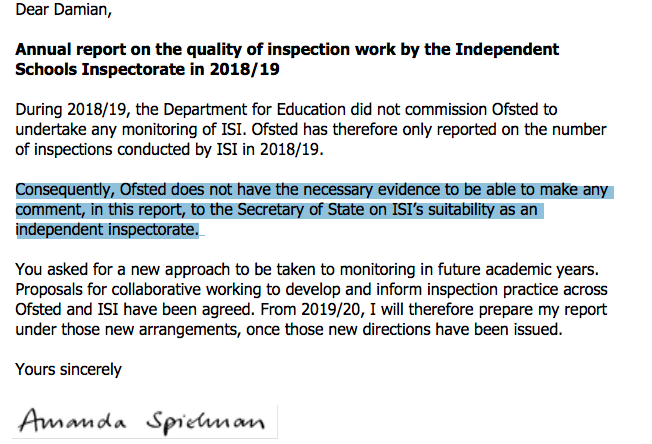
Colin Richards
The private sector prides itself on its independence. A major component of that independence is its “freedom” from direct governmental supervision, including through inspections.
How real is that “freedom”? How has it changed over time? Are independent schools currently freer or more constrained than previously?
At least until the 1944 Education Act, that freedom was real for those schools wishing to exercise it.
In 1906 the Board of Education drew up a list of schools in the country (it was not intended as a comprehensive list, but as a starting point).
If any school wished to be placed on the list, presumably for the promotional value, they were required to submit to inspection by His Majesty’s Inspectors (HMI). These were government inspectors employed by the Board.
Many private schools did not apply initially and were not inspected until much later.
But by 1939, about 750 fee-paying public and preparatory schools were listed – with HMI visiting them and occasionally carrying out full inspections but without publishing their reports.
This constituted a self-imposed but still very restricted limitation on their freedom from public supervision.
Then in 1944 this voluntary light-touch scheme was challenged (though not seriously) by the Education Act that year, which required the appointment of a registrar of independent schools.
This registrar would maintain a register of independent schools ‘open for public inspection at all reasonable times’. HMI were to inspect all independent schools seeking registration.
This part of the Act was only brought into full force some 15 years later in 1959, likely because of the other priorities of post-war governments.
However, in the interim period, HMI had begun to visit and inspect the candidates for registration.
Judging by material in official archives, HMI were appalled by many of the fee-paying schools applying for registration.
Many independent schools closed almost at once, while others leant heavily on advice from visiting HMI to put their houses in order.
It needs to be stressed that those schools accepted onto the register did not constitute some elite club. Registered schools varied significantly in their standards.
Inspection at this time was still only a marginal infringement of a school’s independence from the government.
In the 1980s both the Incorporated Association of Preparatory Schools and the Independent Schools Joint Council introduced their own non-statutory inspection schemes. These comprised former HMIs, but with no direct involvement of serving HMI.
These organisations were the forerunners of today’s Independent Schools Inspectorate (ISI), which inspects the majority of private schools and all those that belong to the Independent Schools Council (about 1,300).
Initially schools belonging to the exclusive Headmasters’ and Headmistresses’ Conference (HMC) did not participate but then decided to do so to “assure the quality and effectiveness of the education, the welfare of pupils and to see that statutory requirements are met”.
Nevertheless, and separate from those inspection schemes, HMI continued to visit independent schools on an occasional basis – sometime as a result of a direct request from the Education Department.
That combination of advice and occasional visits and inspection remained part of HMIs’ brief until the inception of Ofsted in 1992.
So before 1992, all independent schools could be inspected by government inspectors (though it’s important to note, this was not on any consistently planned basis).
After 1992, many independent schools continued to be inspected under the existing non-statutory inspection schemes, and then from 2003 onwards through the statutory-approved Independent Schools Inspectorate.
However, since its inception Ofsted have carried out pre-registration visits to schools wishing to open as private schools, which is then followed by early full inspections that are in line with Ofsted’s own inspection framework (the same as applied to state schools).
Once registered, schools can then choose to join of one seven independent school associations and be subject to inspections carried out by the ISI in relation to its own framework and its own inspectors and with no direct involvement of government inspectors.
If schools choose not to join an association they are inspected according to Ofsted’s framework on a three-year cycle.
This includes schools previously inspected by the Bridge Schools Inspectorate which ceased to be an approved inspector in 2015 following a very adverse report by Ofsted.
More recently, the government intervened to remove numerous private schools, such as fee-paying Steiner schools, from the Schools Inspection Service (SIS: another private schools inspectorate) following lax inspections.
These schools were handed to Ofsted to be inspected, who promptly did a sweep inspection of Steiner schools, most of them private schools, and strongly criticised their standards. Like the Bridge Inspectorate, the SIS is also now closed.
The important point to note is there is a two-tier inspection regime in existence. The use of different inspection frameworks means that inspection reports issued by Ofsted for the schools it oversees and by ISI are not strictly comparable. “Quality” is characterised differently in the two sectors.
The relationship between the two agencies is also problematic. The ISI website still claims that “the work of independent inspectorates is rigorously monitored by Ofsted on behalf of the Department for Education”.
This “rigorous” claim is belied by complaints from Ofsted’s chief inspector, Amanda Spielman, who has stated that so little monitoring activity had been commissioned by the DfE over the previous three years that Ofsted had insufficient evidence to make recommendations about the continued approval of ISI (see below).

A more recent DfE note on the monitoring of independent inspectorates, now being worked through, instructs the chief inspector that she should no longer publish annually her comments on the robustness of ISI’s quality judgments.
The days of any semblance of quality assurance of ISI by HMI are over.
So the situation with public inspection in 2021 is that the freedom from regular government inspection enjoyed by ISC schools is now complete. But should it be?
Meanwhile, those private schools who do not join an independent schools association (or have been removed from now-defunct inspectorates) are subject to more regular and rigorous inspection than ever before.
It really is a paradox.
Colin is a former HM inspector for 13 years, including four with Ofsted, and is also emeritus professor of education at the University of Cumbria.



